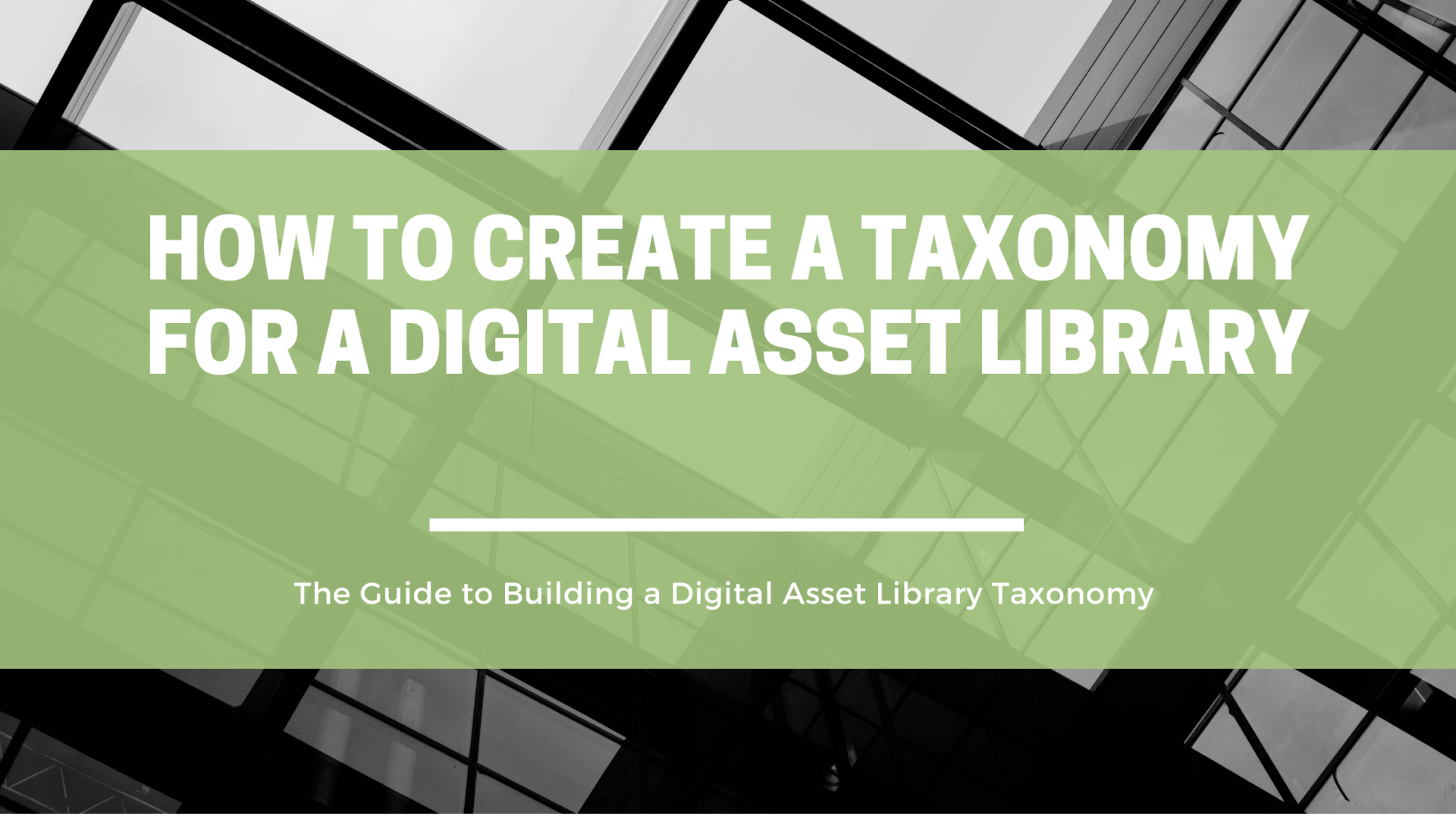How to Build a Digital Asset Library Taxonomy
Nov 4, 2022

Our guide will help you discover more about digital asset management taxonomy, how it can improve digital asset organization, and make discovering your assets more efficient.
Create a Taxonomy For a Digital Asset Library
A well-constructed digital asset taxonomy is the foundation of a successful digital asset management system. It enables all members of an organization to easily find and use the right assets at the right time. In this guide, we will discuss what a taxonomy is and why it is important, as well as best practices for building one out.
We’ll identify great examples in core industries like architecture, engineering, construction, and real estate. Finally, we will provide detailed steps for building an effective DAM taxonomy. Let’s get started!
What is a Digital Asset Taxonomy?
A digital asset taxonomy is a system for categorizing assets within a DAM system. It can be used to organize assets by type, function, or any other classification scheme that makes sense for the organization. As the foundation of your digital asset management system, it should be tailored to suit your company’s unique needs.

A DAM taxonomy typically consists of a hierarchical structure of descriptive terms, with broader terms at the top and more specific terms lower down to make assets easily findable. For example, a taxonomy for architectural drawings might have the following structure:
- Drawings
- Floor Plans
- Residential
- Single Family Home
- Living Room
- Kitchen
- Bathroom
This structure would allow you to easily find all the drawings you need for a single-family home or all the floor plans for residential properties. A thesaurus of sorts, this concrete vocabulary is utilized to describe your team’s digital property. This taxonomy system helps teams tag, organize, and find content efficiently and effectively.
Why is Creating a Strong Taxonomy Important?
A well-organized digital asset library makes it easy for users to find the assets they need in search results. A strong taxonomy can also help improve the overall efficiency of an organization by reducing the amount of time spent searching for assets.
In addition, a powerful taxonomy can be used to automatically generate reports or analytics about the usage of assets within an organization. This can be a game-changer for identifying which assets are being used most often, or which ones may be underutilized.
Here are just a few data points that creative teams can pull from your DAM taxonomy software:
- Most popular search terms
- Number of views or downloads per asset
- Type of usage (e.g. personal, commercial, editorial)
- Geographical location of usage
DAM Taxonomy Best Practices
When you begin to build a taxonomy there are a few routes you can go. One common format is a nested taxonomy. This is where you have a broad category, with subcategories beneath it. For example, under the category of “Animals,” you might have subcategories for “Mammals”, “Birds”, “Reptiles”, etc. Nested taxonomy is similar in style to a computer folder structure.

Another emerging popular format is a flat structure taxonomy. This is where all of the terms are listed on the same level. For example, you might have a list of animals that include “Cats”, “Dogs”, “Lions”, etc. This structure is best for multi-faceted searching when team members want to be able to search for items using multiple terms at the same time.
The benefits of using a flat taxonomy are that it is simpler to maintain, and it can be easier for users to navigate. Users can search quickly and successfully without prior knowledge and browsability is better because all categories are visible. The downside is that it can be more difficult to add new items since they will need to be classified under multiple terms.
There is no right or wrong answer when it comes to deciding which format to use. It really depends on the needs of your library and how you want users to be able to access the assets. Here are a few key things to keep in mind when building your personalized digital asset taxonomy.
1. Keep it Simple
The taxonomy should be easy to understand and use. It should be organized in a way that makes sense for the users and should use language that is familiar to them.
2. Be Consistent
The taxonomy should be consistent across all assets and all users. This will make it easier to find assets for marketing materials and will help prevent confusion.
3. Use Standardized Terms
The existing taxonomy should use standardized terms whenever possible. This will make it easier to search for assets and will ensure that the taxonomy can be easily understood by everyone.
Creating a digital asset taxonomy that is industry specific can help companies keep track of their assets and make it easier to find and use them. Check out these use cases of DAM taxonomy best practices and effective results in action.
Architecture

Architecture leverages all kinds of digital assets such as 2D and 3D drawings, photographs, renders, videos, and more. Creating a taxonomy for all of these assets can be a daunting task but it is essential for maintaining an effective DAM system.
Architecture firm Rogers, Strik, Harbour & Partners witnessed better results in efficiency immediately after setting up a strong taxonomy for their digital asset library. “By installing OpenAsset, RSHP now has a centralized resource of approved images that interfaces with the company’s intranet and project database.”
Engineering

The engineering industry uses more digital assets than you might think. With so many drawings, models, and simulations being created, it’s key to have a well-organized asset management process to optimize findability.
The fast-growing Nitsch Engineering firm found that building a better DAM taxonomy helped boost productivity and increase collaboration across their organization. “With OpenAsset, this 85-person firm drastically slashed time finding and resizing images for use in proposals, award submissions & presentations.”
Construction

Digital assets such as project photos, safety videos, and floor plans are must-haves for construction companies. With so many different types of assets being used in construction, it’s important to have an efficient digital asset management taxonomy that all project partners can use with ease.
Sundt Construction optimized its DAM taxonomy to streamline its workflows and improve the quality of its project proposals. “Everything about the database is useful and time-saving. It’s cut down the time to create everything from proposals to brochures, to PowerPoint presentations. It’s been a huge time-saving tool, and the ease of use made it a no-brainer for us.”
Real Estate

If you’re in the business of buying or selling property, you know that time is of the essence. A well-managed digital asset library can mean the difference between a successful transaction and a costly mistake. A well-crafted digital asset taxonomy can make the difference between a property that languishes on the market and one that sells quickly!
Derwent London, a global real estate development firm, used OpenAsset’s DAM to manage their assets and speed up its sales process. “The system streamlined the creation of marketing materials because of the automatic resizing tool & the easy to use drag & drop feature.”
Steps for Building an Effective DAM Taxonomy?
Ready to build your own custom digital asset taxonomy? Here are concrete steps to get you started building an effective DAM taxonomy:
Understand Your Assets
The first step in building an effective digital asset taxonomy is understanding your assets. What types of assets do you have? What are their characteristics? What are the relationships between them?
Define Asset Types
When creating a digital asset taxonomy, one of the first things you will need to decide is what asset types you will include. Asset types can be broadly defined or very specific, depending on your needs.
Some common asset types that are often included in digital asset taxonomies include:
- Images
- Videos
- Audio files
- Documents
- Presentations
- Spreadsheets
Identify Your Users
The next step is to identify your end users. Who will be using the taxonomy? What are their needs? What types of file formats are they looking for? Developing your taxonomy with user experience in mind will help to ensure that it is usable and effective.
Consider Business Processes
Another important factor to consider when building your taxonomy is how assets will be used within your organization. What processes will they be used in? What workflows will they support? Understanding how assets will be used can help you to create a more effective taxonomy.
Develop a Structure
Once you have identified your assets and users, you can begin to develop a structure for your taxonomy. There are many different ways to structure a taxonomy, but some common methods include by asset type, by location, or by project. Keep your end users in mind to cultivate a more relevant taxonomy structure.
Create Terms and Hierarchies
After you have developed a structure for your taxonomy, you can begin to create terms and hierarchies. Terms are the controlled vocabularies or phrases that you will use to describe your creative assets, and hierarchies are the ways in which those terms are organized. This step will define your tagging structure.
Final Thoughts
One of the main goals of using a content management system is to make content information easier for everyone to find and access. Depending on your preference, you can either use the search bar powered by metadata or category navigation. That’s where your taxonomy is the hero.
The organization of your digital asset management system has a big impact on how easily people can find and use your assets. That’s why it’s important to have a solid foundation and structure that is easy to understand and that meets the specific needs of your users.

If you’re new to the world of digital asset management (DAM) solutions, are looking to upgrade your current structure, or just want to make some tweaks to your DAM structure, these tips will give you a great starting point.
OpenAsset is a high-performance solution in the field of digital asset management. Perfect for firms in the Architecture, Engineering, Construction, and Real Estate industries, our software helps thousands of users manage millions of assets every day. When it comes to building a great DAM taxonomy, we’re the experts! Find out how our high-level DAM platform can integrate with your existing software by requesting a demo today. Request a Demo





